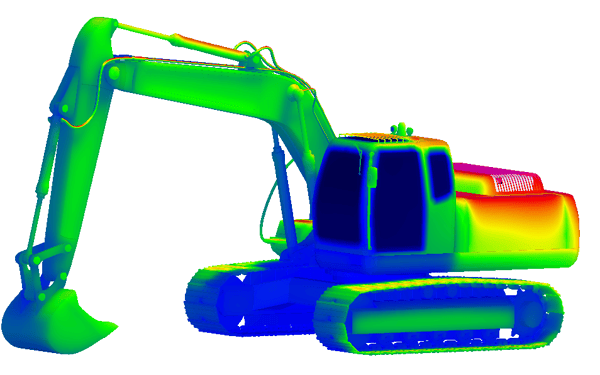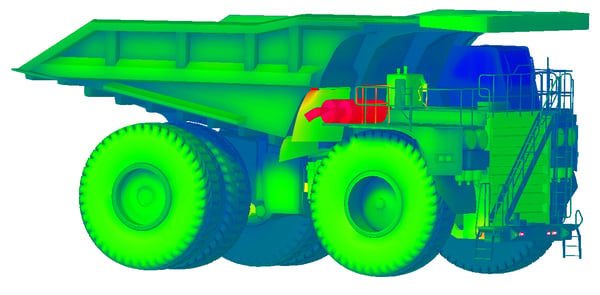The heavy vehicle class — trucks, tractor-trailers, construction equipment, agriculture vehicles, etc. — is perhaps the “hardest working class in the business,” to borrow an expression. Not surprisingly, this class of vehicle presents some unique thermal management issues, distinguishing them from typical automobiles and presenting some distinct challenges when it comes to heat transfer modeling.
Heavy vehicles generally do more than commute passengers. They are often at work — towing, pushing, hauling, trudging and so on. They tend to operate at high powers, which generates more heat both to and from engine components. Additionally, the typical operating cycle for a heavy vehicle is at a high capacity for extended periods, thus resulting in relatively high temperatures for longer periods of time.
It has long been said that slow and steady wins the race, but in some cases, isn’t always beneficial. Heavy vehicles tend to move slower than standard vehicles which means they don’t benefit from as much airflow to cool components. Furthermore, for many of these vehicles, the engine tends not to be in the front of the vehicle, as it would in a car, so what little airflow that does occur may not find its way to the engine as well as it would in a car.
The real world can be a messy place, which further complicates a heavy vehicles airflow. Especially since airflow is needed where these vehicles tend to be at work in dusty or muddy environments where particles, dirt or liquids can partially or totally obstruct the airflow traveling through a grill (picture a tractor working in a dusty field, for example).
Suffice to say, there are a lot of factors that contribute to or detract from the performance of a heavy vehicle, just from a thermal management standpoint alone!
The Dangers in Getting it Wrong
Despite the acknowledgement that heavy vehicles are a unique class with unique thermal management implications, many are still incorrectly or incompletely modeling the potential thermal management performance of these machines. Many manufacturers have historically relied on physical testing and steady-state CFD modeling tools, as opposed to modeling and virtual prototyping with a transient thermal analysis tool to understand the entirety of the vehicle’s thermal performance.
The most common miscalculations arise in these instances:
1.) Using steady-state analysis instead of transient analysis
The general trend in the industry is moving away from steady-state analysis and away from assuming “worst-case scenarios.” The real world is anything but steady, and heavy vehicles are no exception. Simply testing or modeling components against extreme conditions ignores the reality that the heat radiation, conduction and convection will fluctuate over the vehicle’s drive cycle.
As a result of relying on steady-state tools and worst-case scenarios, manufacturers end up over-designing to account for extremes…wasting time, material and costs. And at the end of the day, the analysis isn’t complete, because as soon as you take the vehicle out of the testing environment and into the transient real world, much of the data is rendered irrelevant.
2.) Forgetting that the real world can be a messy place
Picture again that tractor toiling away in the field. Visualize the dirt, or mud or dust, kicking up and clogging the grill. How much of that airflow is now no longer able to reach the engine components to have a cooling effect? Using most analytics technology, one might never account for that very real eventuality, and the performance (and even safety) of the vehicle may be compromised.
Even using CFD software, you may falsely assume that you’d get the same amount of airflow through the grill of a heavy vehicle as you would in a regular road automobile (or a clean grill versus a dirty grill). But operating a truck in heavy dirt and mud, you might have to account for as little as half of the airflow. Using a tool like TAITherm, you could run a temperature sensitivity study to compare full flow of air through the grill versus a grill that is 50% blocked. Knowing that real-world outcome might have a manufacturer changing materials used or designing for additional heat shields or airflow to the under-hood.
Wouldn’t a manufacturer be safer and save more time and money by knowing that information before the vehicle hits the road?
3.) Going with the flow…and only with the flow
The nature of the heavy vehicle class is such that the real-world operating conditions and environment cannot be fully modeled using a CFD tool alone, for all of the reasons stated earlier. In understanding how the heavy vehicle will truly and completely manage heat in the real world, one must first understand what level of meshing should be done in the analysis process. The meshing techniques for CFD tools tend to be surface wrapping, designed to identify and analyze the volume of air around a vehicle.
But surface wrapping airflow accounts only for heat convection (and perhaps not fully accurately, remember). In order to model the complete problem, you need to account for thermal radiation (possibly specular) and, conduction (heat transferred within and through engine components in contact). With more sophisticated tools, you can and should align the level of detail in a simulation to the real-world issues the heavy vehicle will encounter when the rubber literally hits the road: airflow, radiant heat and thermal diffusion in total.
Model Behavior
Heavy vehicles, by the very nature of what they are and what they do, are complex machines that demand complex thermal analytics solutions. Failure to accurately and completely model for transient, real-world operating conditions can result in either a costly over-engineered solution (without design optimization) or misrepresentation of the real "worst case". Ensuring the vehicle is thermally stable under the real operating conditions of the customer is an essential duty of OEMs, as it reduces the risk and likelihood of an undesirable product recall.
Using the right set of thermal management tools will allow manufacturers and designers to “virtually prototype” over many scenarios — rather than physically test under limited conditions — to better understand thermal dynamics of their heavy vehicles. Ultimately, they are able to achieve better performance, safer vehicles and more efficient designs…quicker, and at lower design and manufacturing costs.
To learn more about the benefits of performing three-dimensional, real-world transient analysis on heavy vehicles, or our TAITherm software.

